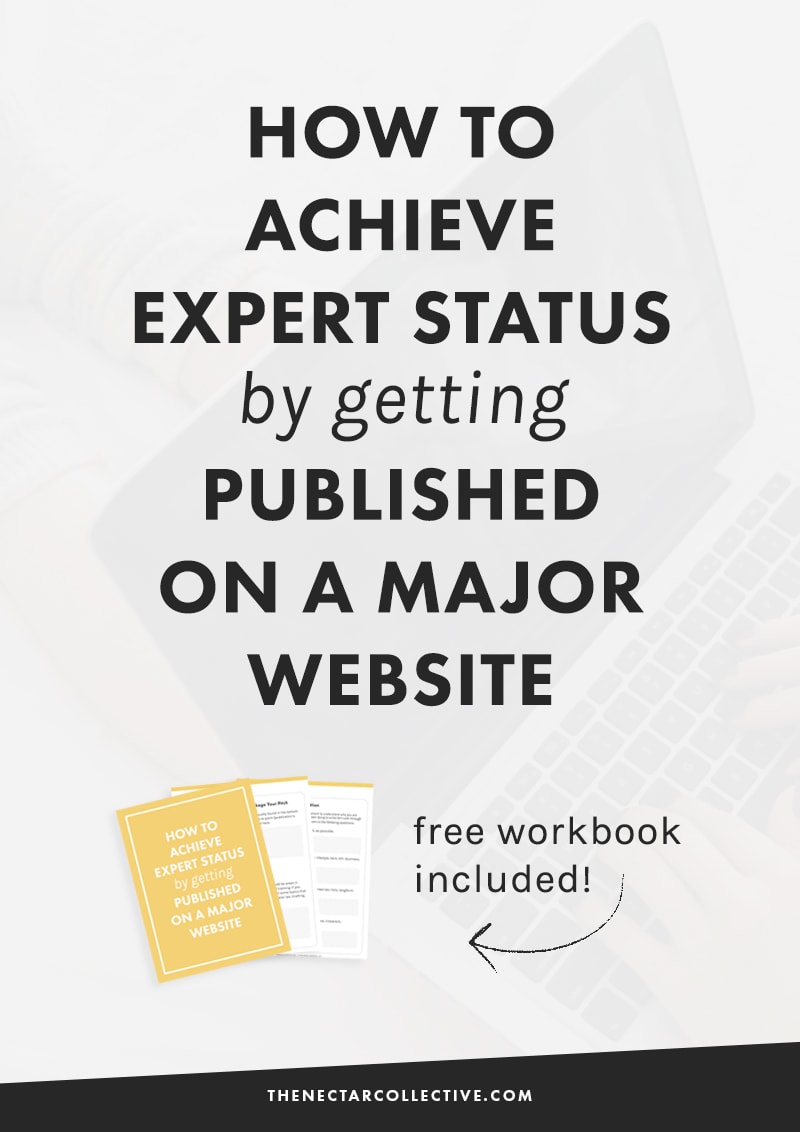Writing an article for a major publication is a great way to say to the world, “Hey, I know my stuff.” Even if writing isn’t your primary gig, publishing an article allows your ideas to be seen by a huge audience (read: new clients), and it can also help establish you as an expert. Think about it: whether it’s career coaching, design, parenting – whatever it is you do very well – you have a ton of specialized knowledge. So imagine how cool it would be to share that specialized knowledge with the readers of, say, The Huffington Post?

But how exactly does one get published on such a big-time site? I was asking myself this same question at the start of my freelance writing career. For the life of me, I couldn’t figure out the steps it took to actually land a published article. It felt like there was some code I needed to crack in order to even get my ideas seen by an editor.
The truth is there’s no code to crack, no particular person you need to know. Instead, it’s all about crafting and packaging a killer pitch. After writing multiple pieces for respected publications, I now have the inside-scoop on how to engage with an editor in order to get a piece published. Looking to land your first big article? Here’s what you’ve got to do:
Get to know the publication
Before you craft a pitch for a publication, be sure to research the types of pieces they usually publish. Be mindful of their audience, their voice, the topics they frequently cover, and use this knowledge to inform the ideas in your pitch.
Think of a publication as a dear friend, and think of your pitch as a gift you are giving them. In order to give them something they will enjoy, you first have to know them. For instance, you wouldn’t give your boy-band-hating friend tickets to a New Kids On The Block concert, would you? In the same way, you probably wouldn’t send a pitch about growing an indoor herb garden to a site like The Washington Post.
Triple-check submission guidelines
Proper submission procedure is likely the #1 thing standing between your pitch being read and your pitch being trashed. While most sites have preferences for how they want writers to pitch their work, every single one is different.
To determine how each site would like for you to package your pitch, you can usually find “Submission” or “Write for us” pages. These pages will hopefully provide an email address as well as instructions for how to structure your pitch (i.e. What to put in the subject line, how many pitches to send, word limit, etc.).
Also, P.S. Unless specifically instructed, don’t send your pitch as an attachment. Editors, as well as most common-sense Internet users, are skeptical of opening attachments from perfect strangers, so sending a Word Document may mean a one-way ticket to the trash.
Find the right contact
If a site does not list submission guidelines, there’s still hope. On a site’s “Contact” page, there are often email addresses listed for editors. Find the one most suited to your topic (ex: Lifestyle Editor, Culture Editor, DIY Editor) and send your email their way.
This is probably a good time to caution you not to get too cute with your email’s subject line. After all, this will be the first thing that an editor sees from you, and while “The Greatest Pitch of All Time” might seem like a charming subject line to you, an editor with a packed inbox might not think so. Just stick to the rules, kid, and if a site doesn’t specify, simply write “Editorial Submission” or the title of your piece.
Be brief
If you’re anything like me, you’re going to have to fight the temptation to turn your pitch into a novel. Editors read so many pitches a day that a lengthy, multi-paragraphed email probably feels like a living nightmare for them. Before you begin your pitch, remember: just. keep. it. simple.
Need extra help pitching to online publications? Check out this free 7-page workbook that walks you through every step:
Lead with your interests and credentials
If you know the name of the editor you are pitching, feel free to address the email to them, but if not, a simple “Hello” is fine (I’m SO over the all-too-impersonal “To whom it may concern…” and I have a feeling I’m not the only one). Then, in one or two sentences, express your interest in writing for their site, and explain why they should care about what you have to say.
But wait, you may be wondering, what if this is my first writing gig? What if I don’t have any credentials yet? Well, first off, you totally do. Whatever you are an expert in, especially in regards to the topic you are pitching, that’s a credential. Second, do you have a blog or website? Boom, credential #2. Or have you ever written a guest blog post on another site? Blam-o, credential #3.
Here’s an example from one of my earliest pitches that led to a published article, back before I had much of a writing resume to speak of at all:
I am an avid reader of _______, and I would love to contribute to your site. In the past, I have written for [publication link], and I daily update a lifestyle/humor blog called Avoiding Atrophy [link].
Nothing too flashy, but the point is clear: I’ve written something in the past, and I am capable of writing something in the future. Note that I’ve also included links to my previous work and my blog.
Here’s another way you could introduce your pitch:
Hello, Below I have listed three ideas for articles that I believe would be a good fit for your site. For samples of my previous work, please visit [***].
*** Could be your blog, a portfolio of some kind, a Tumblr, any piece of writing that you feel is representative of the publication you are pitching. Of course, the more legit the better (i.e. published article > Tumblr post), but obviously, everyone has to start somewhere.
Pitch away
After I introduce myself, I usually transition by saying something like, “Here are my pitches.” If that sounds way too simple, that’s because it is, but again, your prospective editor will appreciate your directness.
Now for the pitch…
A pitch is exactly that: a pitch. It is not in itself a written piece, but rather it is the concept for a piece that you intend to write. While you can send fully completed stories (I have had articles published this way), the general practice is to submit your ideas first so that an editor can work with you from the beginning stages of the project.
Now, remember, you will want to defer to whatever submission guidelines a publication has laid out for you, but in general, I have had the most success with pitches that are no more than four sentences long. Within those four sentences, provide your headline (the title of your piece, written in the style of the publication you are pitching), your idea (the general concept of the article), and your angle (your take/slant/point of view – basically the reason why this article will be interesting).
Here’s an example of a pitch I sent that led to a published article for Salon (for the record, I was writing about pop culture at the time):
The thriving subculture of people who still watch “Survivor” — The 15th anniversary of the U.S. version of Survivor is coming up on May 31, and while the show no longer stands as the undisputed king of reality TV ratings, Survivor maintains an incredibly dedicated fan base. This article will examine why this show has remained so captivating over the last fifteen years and how exactly fans interact with the show today. Through podcasts, viewing parties, and Twitter debates, there is a committed segment of the population that can’t get enough of a show that much of the rest of the world has long-forgotten.
Provide next steps
After you wow an editor with your pitch(es), conclude your email with the following information:
- A submission timeline –Let your editor know how long you think this piece will take you to write. Reminder: you are not a magician, so be realistic here. For the record, depending on what I’m pitching, I usually say I can turn a piece around within 3-5 days.
- A response “deadline” – This is an idea I learned from an essay by Mandy Stadtmiller at xoJane, and it was a game-changer for me. You see, editors are obviously busy people, so they may take a while to respond to your pitch. Still, it’s okay to provide a “deadline” of sorts. Let them know that if you don’t receive a response within a certain amount of time (ex: 2 weeks), you will continue pitching your ideas elsewhere. And by the way, actually pitch these same ideas to other publications.
- All of the usual niceness that comes with an email – Provide a way for the editor to reach you, and say things like Thank you…If you have any questions…etc. You know, be nice.
Follow up
If you don’t hear back within the week, feel free to send a follow up email. Who knows, your pitch could have gotten lost in the abyss that is an editor’s inbox, so sending a gentle reminder might be the thing that helps it get seen. It could also mean that an inevitable “no” might just come a bit sooner, and hey that’s okay. At least then you’ll know to just keep on pitching somewhere else.













